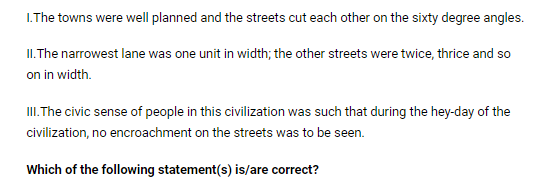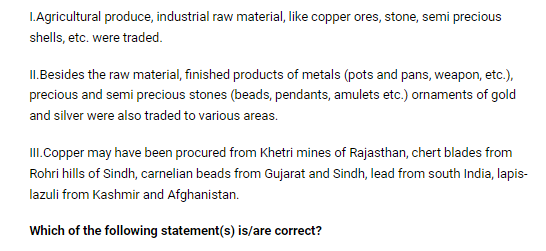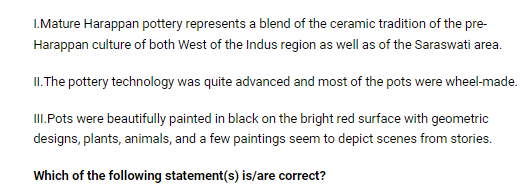1. The Harappan Civilisation is referred as a:
The Harappan civilisation is referred described as a bronze era culture. Most artefacts were made from unalloyed copper, and tin was only occasionally alloyed with copper to form bronze.
2. Which of the following materials was used in the Harappan seals?
More than 2500 seals have been found. These are steatite-made. They typically portray a single animal—unicorn bulls, elephants, rhinoceroses, etc.—but some also depict trees, semi-human and human figures, which in some instances are part of a ceremony.
3. Consider the following statements regarding the planning of streets of Harappan towns:

The most notable characteristics of the Harappan civilization are its well-planned and drain-equipped streets and byways. The settlements were well-designed, with streets intersecting at right angles. Even the widths of these streets were proportional to one another. If the narrowest street was one unit wide, the remaining streets were twice, three times, etc. wider. Moreover, the civic awareness of the inhabitants in this civilisation was such that there was no street encroachment throughout the civilization's heyday. According to academics, such urban planning did not exist in London or Paris during the nineteenth century.
4. Consider the following statements regarding the activities of trade and commerce done by the Harappan people:

Agriculture and industrial raw materials, such as copper ore, stone, and semiprecious shells, were traded. In addition to the raw material, finished metal items (pots and pans, weapons, etc.), precious and semi-precious stones (beads, pendants, amulets, etc.), and gold and silver decorations were traded to different regions. Copper could have been obtained from the Khetri mines of Rajasthan, chert blades from the Rohri hills of Sindh, carnelian beads from Gujarat and Sindh, lead from southern India, lapis-lazuli from Kashmir and Afghanistan, turquoise and jade from central Asia or Iran, amethyst from Maharashtra, and agate, chalcedony, and carnelian from Saurashtra.
5. Consider the following statements regarding mature Harappan pottery:

Harappan pottery reflects a synthesis of the ceramic traditions of the pre-Harappan cultures of both the west of the Indus and the Saraswati river regions. The pottery techniques were highly sophisticated. Most of the pots were created on a wheel. Large storage jars were also manufactured. On the bright red surface of the pots were intricate black paintings of geometric patterns, flora, animals, and what appear to be scenes from legends.
6. Consider the following statements regarding the tools and vessels used by Harappan people:
The forms of tools and weapons were simple. They were comprised of flat-axes, chisels, arrowheads, spearheads, knives, saws, razors, and fish-hooks. People also created copper and bronze vessels. They crafted intricate gold and silver jewellery, as well as little plates and weights made of lead.
7. Till the time of partition of India, how many Harappan settlements have been explored?
At the time of partition of India in 1947, barely 40 settlements belonging to Indus Valley civilization were known. Researches, carried, out during the last 50 years have altered the picture completely.
8. Mohenjodaro, one of the sites of Harappan civilization was discovered by which of the following archaeologist?
The Indian historian Rakhaldas Bandyopadhyay, better known by his pen as R. D. Banerji, is regarded as a pioneer in the fields of Indian palaeography, epigraphy, and archaeology. At the Banaras Hindu University, he held the Manindra Chandra Nandy Professorship of Ancient Indian History and Culture from 1928 to 1930. He is most known for having found Mohenjodaro, the main Harappa civilization site.
9. The site at Harappa was discovered by which of the following archaeologists?
Harappan civilization was discovered in 1920-21 following the excavations by R.D. Banerjee at Mohenjodaro and by D.R. Salini at Harappa. Since at that time the remains of the civilization were found only in the Indus valley, it came to be known also as the Indus civilization.
10. Which of the following Indus Valley settlements were located in Rann of Kachchha?
One can categorise the majority of the 1400 communities that make up this civilisation as tiny villages (up to 10 hectares), a few larger towns, and small cities (10 to 50 hectares). Mohenjodaro (+ 250 hectares), Harappa (+ 150 hectares), Ganawariwala (+ 80 hectares), Rakhigarhi (+ 80 hectares), Kalibangan (+ 100 hectares), and Dholavira (+ 100 hectares) are a few of the towns that can readily be categorised as major cities. The first five are inland centres spread out in a zigzag pattern across the Indus and Saraswati river plain, roughly equidistant from one another. The final two are in Kachchha's Rann.
Share your Results:
